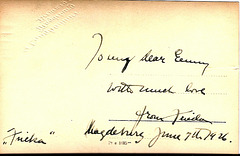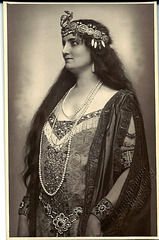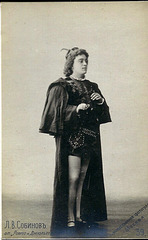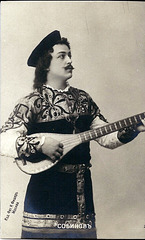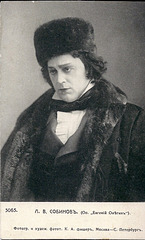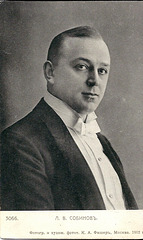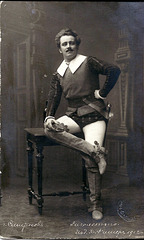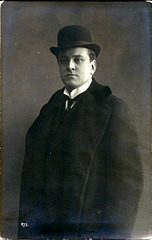OperaMania's photos
Frida Leider
Frida Leider
| |
|
as Fricka "Die Walkure" Wagner
Frida Leider
1888-1975
German Soprano
Studied singing while working in a bank. Her first engagements led her to opera houses in Halle, Königsberg, and Rostock. After an engagement with the Hamburg State Opera in 1923, she was hired by the Berlin State Opera as first dramatic soprano. After her retirement from the stage in 1946, she remained there as the director and manager of a studio for the rising singers of the Berlin State Opera.
Frida Leider made regular guest appearances for over 15 years at the Royal Opera House at Covent Garden in London, at the Metropolitan Opera in New York, at La Scala in Milan, and at the State Operas of Vienna and Munich. Naturally, she also made appearances at the Bayreuth Festival, where she was the unrivaled star soprano of the 1930s. In the 1920s, she alternated Wagnerian roles with Florence Austral at Covent Garden .Leider married the first concert master of the Berlin State Opera, Prof. Rudolf Deman. Her most famous roles were Wagner's Isolde and Brünnhilde, Beethoven's Fidelio, Mozart's Donna Anna, and Verdi's Aida and Leonora.
Frida Leider
| |
|
as 'Aida in "Aida" by Verdi
Frida Leider
1888-1975
German Soprano
Studied singing while working in a bank. Her first engagements led her to opera houses in Halle, Königsberg, and Rostock. After an engagement with the Hamburg State Opera in 1923, she was hired by the Berlin State Opera as first dramatic soprano. After her retirement from the stage in 1946, she remained there as the director and manager of a studio for the rising singers of the Berlin State Opera.
Frida Leider made regular guest appearances for over 15 years at the Royal Opera House at Covent Garden in London, at the Metropolitan Opera in New York, at La Scala in Milan, and at the State Operas of Vienna and Munich. Naturally, she also made appearances at the Bayreuth Festival, where she was the unrivaled star soprano of the 1930s. In the 1920s, she alternated Wagnerian roles with Florence Austral at Covent Garden .Leider married the first concert master of the Berlin State Opera, Prof. Rudolf Deman. Her most famous roles were Wagner's Isolde and Brünnhilde, Beethoven's Fidelio, Mozart's Donna Anna, and Verdi's Aida and Leonora.
Nellie Melba
| |
|
as Violetta in "La Traviata" by Verdi
Dame NELLIE MELBA GBE
(Helen Porter Mitchell)
(19 May 1861 – 23 February 1931),
Australian Soprano
Melba was taught to play the piano and first sang in public around age six.She was educated at a local boarding school and then at the Presbyterian Ladies' College. She studied singing with Mary Ellen Christian (a former pupil of Manuel García) and Pietro Cecchi, an Italian tenor, who was a respected teacher in Melbourne. In her teens, Melba continued to perform in amateur concerts in and around Melbourne, and she played the organ at church. Making her professional debut in Melbourne concerts in 1884. On the strength of local success, she travelled to London in search of an opportunity.Her debut at the Princes' Hall in 1886 made little impression, and she sought work unsuccessfully from Sir Arthur Sullivan, Carl Rosa and Augustus Harris.She then went to Paris to study with the leading teacher Mathilde Marchesi, who instantly recognised the young singer's potential: Melba made such rapid progress that she was allowed to sing the "Mad Scene" from Ambroise Thomas's Hamlet at a matinée musicale in Marchesi's house in December the same year, in the presence of the composer.Her talent was so evident that, after less than a year with Marchesi, the impresario Maurice Strakosch gave her a ten-year contract at 1000 francs annually. After she had signed, she received a far better offer of 3000 francs per month from the Théâtre de la Monnaie, Brussels, but Strakosch would not release her and obtained an injunction preventing her from performing .The matter was resolved by Strakosch's sudden death.She made her operatic debut four days later as Gilda in Rigoletto at La Monnaie on 12 October 1887.. It was at this time, on Marchesi's advice, that she adopted the stage name of "Melba", a contraction of the name of her home city.Her Covent Garden début in May 1888, in the title role in Lucia di Lammermoor. She received a friendly but not excited reception The following year, she performed at the Opéra in Paris, in the role of Ophélie in Hamlet; She travelled across Europe to St Petersburg to sing for Tsar Nicholas II: and sang in Paris, Brussels, Vienna , Milan, and Berlin Melba sang the role of Nedda in Pagliacci at Covent Garden in 1893, soon after its Italian premiere. The composer was present, and said that the role had never been so well played before.[19] In December of that year, Melba sang at the Metropolitan Opera in New York for the first time. As at her Covent Garden debut, she appeared as Lucia di Lammermoor, Her Roles included mostly in the lyric soprano repertoire, but with some heavier roles also. She sang the title roles in Herman Bemberg's Elaine and Arthur Goring Thomas's Esmeralda. Her Italian parts included Gilda in Rigoletto, the title role in Aida Desdemona in Otello, Luisa in Mascagni's I Rantzau, Nedda in Pagliacci, Rosina in The Barber of Seville, Violetta in La traviata, and Mimi in La bohème. In the French repertoire, she sang Juliette in Roméo et Juliette, Marguerite in Faust, Marguerite de Valois in Les Huguenots, the title role in Saint-Saëns's Hélène, which was written for her, and Micaëla in Carmen.
Emma Albani by Gurney (6)
| |
|
EMMA ALBANI
(1 November 1847 – 3 April 1930)
Canadian soprano
(Marie Louise Cecilia Emma Lajeunesse.)
Vocal studies in Europe, and she became a student of Gilbert Louis Duprez in Paris, then by Francesco Lamperti in Milan. Debut in 1870 at the Opera House of Messina as Amina in 'La Sonnambula'. Covent Garden début 1872. First Covent Garden Senta (Der fliegende Holländer), 1877. NY Met début 1891; first Desdemona at NY Met 1894. Sang Isolde, Covent Garden 1896, retiring from stage a month later, but continuing to sing in oratorio. Retired to teach in 1911. DBE 1925.
Nellie Melba by Reutlinger
| |
|
as Elizabeth in "Tannhauser" by Wagner
Dame NELLIE MELBA GBE
(Helen Porter Mitchell)
(19 May 1861 – 23 February 1931),
Australian Soprano
Melba was taught to play the piano and first sang in public around age six.She was educated at a local boarding school and then at the Presbyterian Ladies' College. She studied singing with Mary Ellen Christian (a former pupil of Manuel García) and Pietro Cecchi, an Italian tenor, who was a respected teacher in Melbourne. In her teens, Melba continued to perform in amateur concerts in and around Melbourne, and she played the organ at church. Making her professional debut in Melbourne concerts in 1884. On the strength of local success, she travelled to London in search of an opportunity.Her debut at the Princes' Hall in 1886 made little impression, and she sought work unsuccessfully from Sir Arthur Sullivan, Carl Rosa and Augustus Harris.She then went to Paris to study with the leading teacher Mathilde Marchesi, who instantly recognised the young singer's potential: Melba made such rapid progress that she was allowed to sing the "Mad Scene" from Ambroise Thomas's Hamlet at a matinée musicale in Marchesi's house in December the same year, in the presence of the composer.Her talent was so evident that, after less than a year with Marchesi, the impresario Maurice Strakosch gave her a ten-year contract at 1000 francs annually. After she had signed, she received a far better offer of 3000 francs per month from the Théâtre de la Monnaie, Brussels, but Strakosch would not release her and obtained an injunction preventing her from performing .The matter was resolved by Strakosch's sudden death.She made her operatic debut four days later as Gilda in Rigoletto at La Monnaie on 12 October 1887.. It was at this time, on Marchesi's advice, that she adopted the stage name of "Melba", a contraction of the name of her home city.Her Covent Garden début in May 1888, in the title role in Lucia di Lammermoor. She received a friendly but not excited reception The following year, she performed at the Opéra in Paris, in the role of Ophélie in Hamlet; She travelled across Europe to St Petersburg to sing for Tsar Nicholas II: and sang in Paris, Brussels, Vienna , Milan, and Berlin Melba sang the role of Nedda in Pagliacci at Covent Garden in 1893, soon after its Italian premiere. The composer was present, and said that the role had never been so well played before.[19] In December of that year, Melba sang at the Metropolitan Opera in New York for the first time. As at her Covent Garden debut, she appeared as Lucia di Lammermoor, Her Roles included mostly in the lyric soprano repertoire, but with some heavier roles also. She sang the title roles in Herman Bemberg's Elaine and Arthur Goring Thomas's Esmeralda. Her Italian parts included Gilda in Rigoletto, the title role in Aida Desdemona in Otello, Luisa in Mascagni's I Rantzau, Nedda in Pagliacci, Rosina in The Barber of Seville, Violetta in La traviata, and Mimi in La bohème. In the French repertoire, she sang Juliette in Roméo et Juliette, Marguerite in Faust, Marguerite de Valois in Les Huguenots, the title role in Saint-Saëns's Hélène, which was written for her, and Micaëla in Carmen.
Frances Alda by Aime Dupont
| |
|
as Anna in "La Villi" by Puccini
FRANCES ALDA
(Fanny Jane Davis)
(31 May 1879– 18 September 1952 )
New Zealand Soprano
Was a New Zealand-born, Australian-raised .Her Opera Comique debut in 1904 and which she sang 52 times at La Monnaie in Brussels as well as at La Scala where she was the first Louise under Toscanini and sang opposite Chaliapin in Mefistofole.- (1906-1908). She debuted at the Met in 1908 as Gilda & in 1909 married Gatti-Casazza La Scala's impresario who moved to the Met. A Marchesi pupil and versatile artiste she sang 369 performances at the Met including world premieres of operas by Hadley, Herbert & Damrosch as well standard and unusual roles in the French and Italian repertory often opposite Caruso. She was a prolific recorder and gave extensive concert tours. Very outspoken her autobio Men Women and Tenors is a must.
Ben Davies by Elliott & Fry
| |
|
Ben Davies
1858-1943
Welsh Tenor
Studied at Royal Academy of Music with Alberto Randegger and Signor Fiori.Debut 1881 as Thaddeus in “The Bohemian Girlf” by Balfe .Created Gringaire in “Esmerelda” by Goring-Thomas at Drury lane 1883 ,Martin Bolder in “”Doris” by Cellier and Ralph Rodney in “The Red Hussar” by Solomon 1889 , Ivanhoe in “Ivanhoe” by Sullivan in 1891 at the Palace theatre. .He appeared in the Premiere of “Signa” by Cowan.He made a Covent Garden debut as Faust in “Faust” by Gounod in 1892 .After 1893 his career moved largely into the concert platform .He sang oratorio at Music Festivals around Britain and made tours of Australia and USA.
Leonid Sobinov
| |
|
as Romeo in "Romeo and Juliette" by Gounod
Leonid Sobinov
1872-1934
Russian Tenor
Studied at Moscow Conservatory from 1892 with Alexander Dodonov and Alexandra Santagano Gorchakova.He appeared on stage with a travelling Italian opera troupe as Beppe in “I Pagliacci” by Leoncavallo and the steersman in ‘The Flying Dutchman” by Wagner . His official debut was as Sinodal in “The Demon” by Rubinstein in 1897 at the Bolshoi where remained for seven years before joining Mamontov’s Opera.In 1904 he sang Ernesto in ‘Don Pasquale” by Dinizetti at La Scala Milan,After 1907 he divided his perfamces between the Mariinsky and the Bolshoi . He also sang at monte Carlo , Warsaw , Helsinki,Berlin and Paris.His farewell was in 1933 at the Bolshoi he was at one time Director of the Bolshoi and later taught at Stanislvsky’s opera studio. His roles finn in “Ruslan and Ludmila” Glinka , Faust “Faust” Gounod Vladamir “ Prince Igor” Borodin , Lensky “Eugene Onegin” Tchaikovsky, Duke “Rigoletto” Verdi , Lohengrin “Lohengrin” Wagner , Walther “Tannhäuser” Wagner ,Solovey “Zabava Putyatishna” Ivanov and Janusz “Halka” Moniuszko
Leonid Sobinov
| |
|
as Solovey in "Zabava Putyatishna" by Ivanov
Leonid Sobinov
1872-1934
Russian Tenor
Studied at Moscow Conservatory from 1892 with Alexander Dodonov and Alexandra Santagano Gorchakova.He appeared on stage with a travelling Italian opera troupe as Beppe in “I Pagliacci” by Leoncavallo and the steersman in ‘The Flying Dutchman” by Wagner . His official debut was as Sinodal in “The Demon” by Rubinstein in 1897 at the Bolshoi where remained for seven years before joining Mamontov’s Opera.In 1904 he sang Ernesto in ‘Don Pasquale” by Dinizetti at La Scala Milan,After 1907 he divided his perfamces between the Mariinsky and the Bolshoi . He also sang at monte Carlo , Warsaw , Helsinki,Berlin and Paris.His farewell was in 1933 at the Bolshoi he was at one time Director of the Bolshoi and later taught at Stanislvsky’s opera studio. His roles finn in “Ruslan and Ludmila” Glinka , Faust “Faust” Gounod Vladamir “ Prince Igor” Borodin , Lensky “Eugene Onegin” Tchaikovsky, Duke “Rigoletto” Verdi , Lohengrin “Lohengrin” Wagner , Walther “Tannhäuser” Wagner ,Solovey “Zabava Putyatishna” Ivanov and Janusz “Halka” Moniuszko
Leonid Sobinov
| |
|
as Lenski in "Eugene Onegin" by Tchaikovsky
Leonid Sobinov
1872-1934
Russian Tenor
Studied at Moscow Conservatory from 1892 with Alexander Dodonov and Alexandra Santagano Gorchakova.He appeared on stage with a travelling Italian opera troupe as Beppe in “I Pagliacci” by Leoncavallo and the steersman in ‘The Flying Dutchman” by Wagner . His official debut was as Sinodal in “The Demon” by Rubinstein in 1897 at the Bolshoi where remained for seven years before joining Mamontov’s Opera.In 1904 he sang Ernesto in ‘Don Pasquale” by Dinizetti at La Scala Milan,After 1907 he divided his perfamces between the Mariinsky and the Bolshoi . He also sang at monte Carlo , Warsaw , Helsinki,Berlin and Paris.His farewell was in 1933 at the Bolshoi he was at one time Director of the Bolshoi and later taught at Stanislvsky’s opera studio. His roles finn in “Ruslan and Ludmila” Glinka , Faust “Faust” Gounod Vladamir “ Prince Igor” Borodin , Lensky “Eugene Onegin” Tchaikovsky, Duke “Rigoletto” Verdi , Lohengrin “Lohengrin” Wagner , Walther “Tannhäuser” Wagner ,Solovey “Zabava Putyatishna” Ivanov and Janusz “Halka” Moniuszko
Leonid Sobinov
| |
|
as Lenski in "Eugene Onegin" by Tchaikovsky
Leonid Sobinov
1872-1934
Russian Tenor
Studied at Moscow Conservatory from 1892 with Alexander Dodonov and Alexandra Santagano Gorchakova.He appeared on stage with a travelling Italian opera troupe as Beppe in “I Pagliacci” by Leoncavallo and the steersman in ‘The Flying Dutchman” by Wagner . His official debut was as Sinodal in “The Demon” by Rubinstein in 1897 at the Bolshoi where remained for seven years before joining Mamontov’s Opera.In 1904 he sang Ernesto in ‘Don Pasquale” by Dinizetti at La Scala Milan,After 1907 he divided his perfamces between the Mariinsky and the Bolshoi . He also sang at monte Carlo , Warsaw , Helsinki,Berlin and Paris.His farewell was in 1933 at the Bolshoi he was at one time Director of the Bolshoi and later taught at Stanislvsky’s opera studio. His roles finn in “Ruslan and Ludmila” Glinka , Faust “Faust” Gounod Vladamir “ Prince Igor” Borodin , Lensky “Eugene Onegin” Tchaikovsky, Duke “Rigoletto” Verdi , Lohengrin “Lohengrin” Wagner , Walther “Tannhäuser” Wagner ,Solovey “Zabava Putyatishna” Ivanov and Janusz “Halka” Moniuszko
Leonid Sobinov
| |
|
as Lenski in "Eugene Onegin" by Tchaikovsky
Leonid Sobinov
1872-1934
Russian Tenor
Studied at Moscow Conservatory from 1892 with Alexander Dodonov and Alexandra Santagano Gorchakova.He appeared on stage with a travelling Italian opera troupe as Beppe in “I Pagliacci” by Leoncavallo and the steersman in ‘The Flying Dutchman” by Wagner . His official debut was as Sinodal in “The Demon” by Rubinstein in 1897 at the Bolshoi where remained for seven years before joining Mamontov’s Opera.In 1904 he sang Ernesto in ‘Don Pasquale” by Dinizetti at La Scala Milan,After 1907 he divided his perfamces between the Mariinsky and the Bolshoi . He also sang at monte Carlo , Warsaw , Helsinki,Berlin and Paris.His farewell was in 1933 at the Bolshoi he was at one time Director of the Bolshoi and later taught at Stanislvsky’s opera studio. His roles finn in “Ruslan and Ludmila” Glinka , Faust “Faust” Gounod Vladamir “ Prince Igor” Borodin , Lensky “Eugene Onegin” Tchaikovsky, Duke “Rigoletto” Verdi , Lohengrin “Lohengrin” Wagner , Walther “Tannhäuser” Wagner ,Solovey “Zabava Putyatishna” Ivanov and Janusz “Halka” Moniuszko
Leonid Sobinov
| |
|
Leonid Sobinov
1872-1934
Russian Tenor
Studied at Moscow Conservatory from 1892 with Alexander Dodonov and Alexandra Santagano Gorchakova.He appeared on stage with a travelling Italian opera troupe as Beppe in “I Pagliacci” by Leoncavallo and the steersman in ‘The Flying Dutchman” by Wagner . His official debut was as Sinodal in “The Demon” by Rubinstein in 1897 at the Bolshoi where remained for seven years before joining Mamontov’s Opera.In 1904 he sang Ernesto in ‘Don Pasquale” by Dinizetti at La Scala Milan,After 1907 he divided his perfamces between the Mariinsky and the Bolshoi . He also sang at monte Carlo , Warsaw , Helsinki,Berlin and Paris.His farewell was in 1933 at the Bolshoi he was at one time Director of the Bolshoi and later taught at Stanislvsky’s opera studio. His roles finn in “Ruslan and Ludmila” Glinka , Faust “Faust” Gounod Vladamir “ Prince Igor” Borodin , Lensky “Eugene Onegin” Tchaikovsky, Duke “Rigoletto” Verdi , Lohengrin “Lohengrin” Wagner , Walther “Tannhäuser” Wagner ,Solovey “Zabava Putyatishna” Ivanov and Janusz “Halka” Moniuszko
Dmitri Smirnov
| |
|
as Duke in "Rigoletto" by Verdi
Dmitri Smirnov
1882-1944
Russian Tenor
Studied with Emiliya Pavlovskaya and Alexander Dodonov .Début in St Petersburg in 1903 as Gigi in “La Camorra” by Esposito .Became a member of the Bolshoi company in Moscow, in 1904 singing there until 1910. He then sang at the Mariinsky Theatre, St Petersburg, from 1911 to 1917. French début at the Paris Opéra in 1907. Invited to appear at the Metropolitan Opera, where he sang in 1911-12. In 1914, he performed in the "Russian Seasons" at London's Theatre Royal, Drury Lane. He would not sing in the United States again except for two performances of Tchaikovsky's The Queen of Spades with theWashington National Opera—a semi-professional company not related to its present namesake—in 1926.Left his native land after the Russian Revolution of 1917, preferring to continue his career in the West. Among the cities which he visited were Berlin, Monte Carlo, Milan, Rome, Madrid and Buenos Aires. Gave his last recitals during the 1930s. He taught singing in London and Athens and later retired to Riga
Dmitri Smirnov
| |
|
as Romeo in "Romeo and Juliette" by Gounod
Dmitri Smirnov
1882-1944
Russian Tenor
Studied with Emiliya Pavlovskaya and Alexander Dodonov .Début in St Petersburg in 1903 as Gigi in “La Camorra” by Esposito .Became a member of the Bolshoi company in Moscow, in 1904 singing there until 1910. He then sang at the Mariinsky Theatre, St Petersburg, from 1911 to 1917. French début at the Paris Opéra in 1907. Invited to appear at the Metropolitan Opera, where he sang in 1911-12. In 1914, he performed in the "Russian Seasons" at London's Theatre Royal, Drury Lane. He would not sing in the United States again except for two performances of Tchaikovsky's The Queen of Spades with theWashington National Opera—a semi-professional company not related to its present namesake—in 1926.Left his native land after the Russian Revolution of 1917, preferring to continue his career in the West. Among the cities which he visited were Berlin, Monte Carlo, Milan, Rome, Madrid and Buenos Aires. Gave his last recitals during the 1930s. He taught singing in London and Athens and later retired to Riga
Dmitri Smirnov
| |
|
as Lenski in "Eugene Onegin" by Tchaikovsky
Dmitri Smirnov
1882-1944
Russian Tenor
Studied with Emiliya Pavlovskaya and Alexander Dodonov .Début in St Petersburg in 1903 as Gigi in “La Camorra” by Esposito .Became a member of the Bolshoi company in Moscow, in 1904 singing there until 1910. He then sang at the Mariinsky Theatre, St Petersburg, from 1911 to 1917. French début at the Paris Opéra in 1907. Invited to appear at the Metropolitan Opera, where he sang in 1911-12. In 1914, he performed in the "Russian Seasons" at London's Theatre Royal, Drury Lane. He would not sing in the United States again except for two performances of Tchaikovsky's The Queen of Spades with theWashington National Opera—a semi-professional company not related to its present namesake—in 1926.Left his native land after the Russian Revolution of 1917, preferring to continue his career in the West. Among the cities which he visited were Berlin, Monte Carlo, Milan, Rome, Madrid and Buenos Aires. Gave his last recitals during the 1930s. He taught singing in London and Athens and later retired to Riga
Dmitri Smirnov
| |
|
Dmitri Smirnov
1882-1944
Russian Tenor
Studied with Emiliya Pavlovskaya and Alexander Dodonov .Début in St Petersburg in 1903 as Gigi in “La Camorra” by Esposito .Became a member of the Bolshoi company in Moscow, in 1904 singing there until 1910. He then sang at the Mariinsky Theatre, St Petersburg, from 1911 to 1917. French début at the Paris Opéra in 1907. Invited to appear at the Metropolitan Opera, where he sang in 1911-12. In 1914, he performed in the "Russian Seasons" at London's Theatre Royal, Drury Lane. He would not sing in the United States again except for two performances of Tchaikovsky's The Queen of Spades with theWashington National Opera—a semi-professional company not related to its present namesake—in 1926.Left his native land after the Russian Revolution of 1917, preferring to continue his career in the West. Among the cities which he visited were Berlin, Monte Carlo, Milan, Rome, Madrid and Buenos Aires. Gave his last recitals during the 1930s. He taught singing in London and Athens and later retired to Riga

